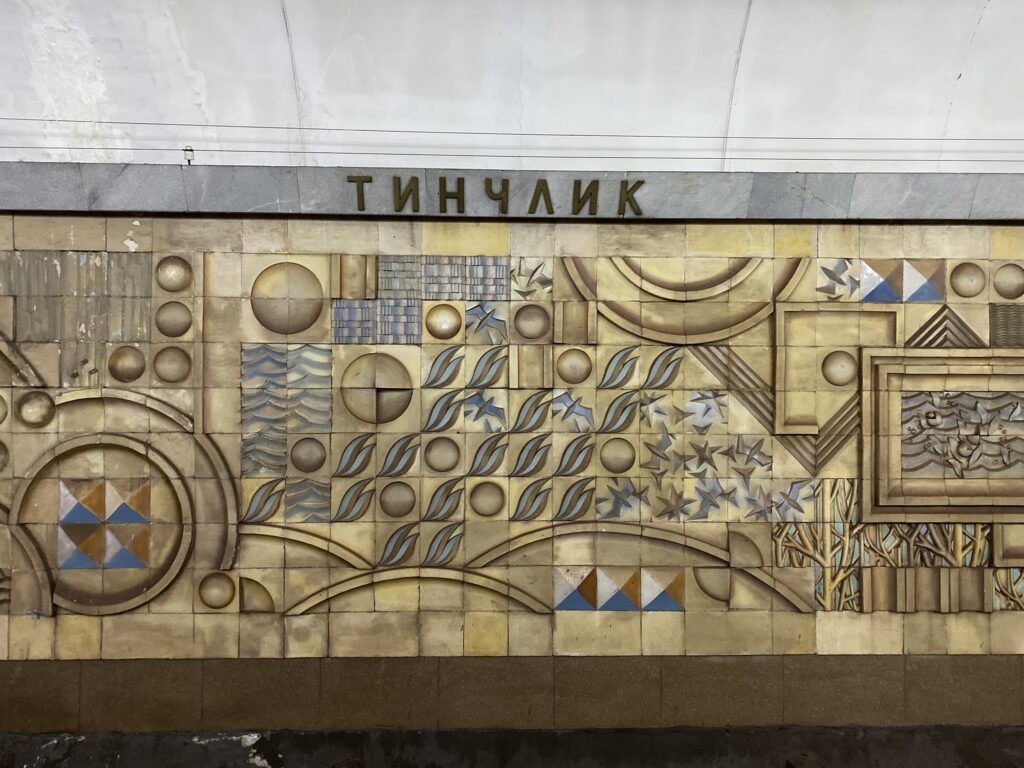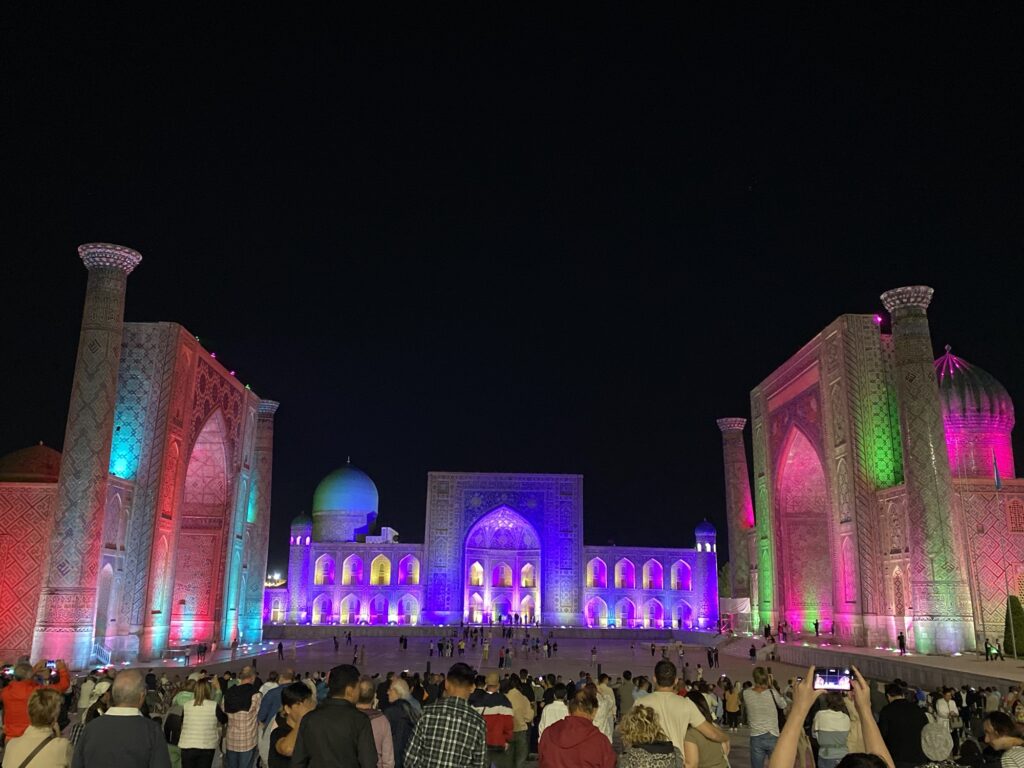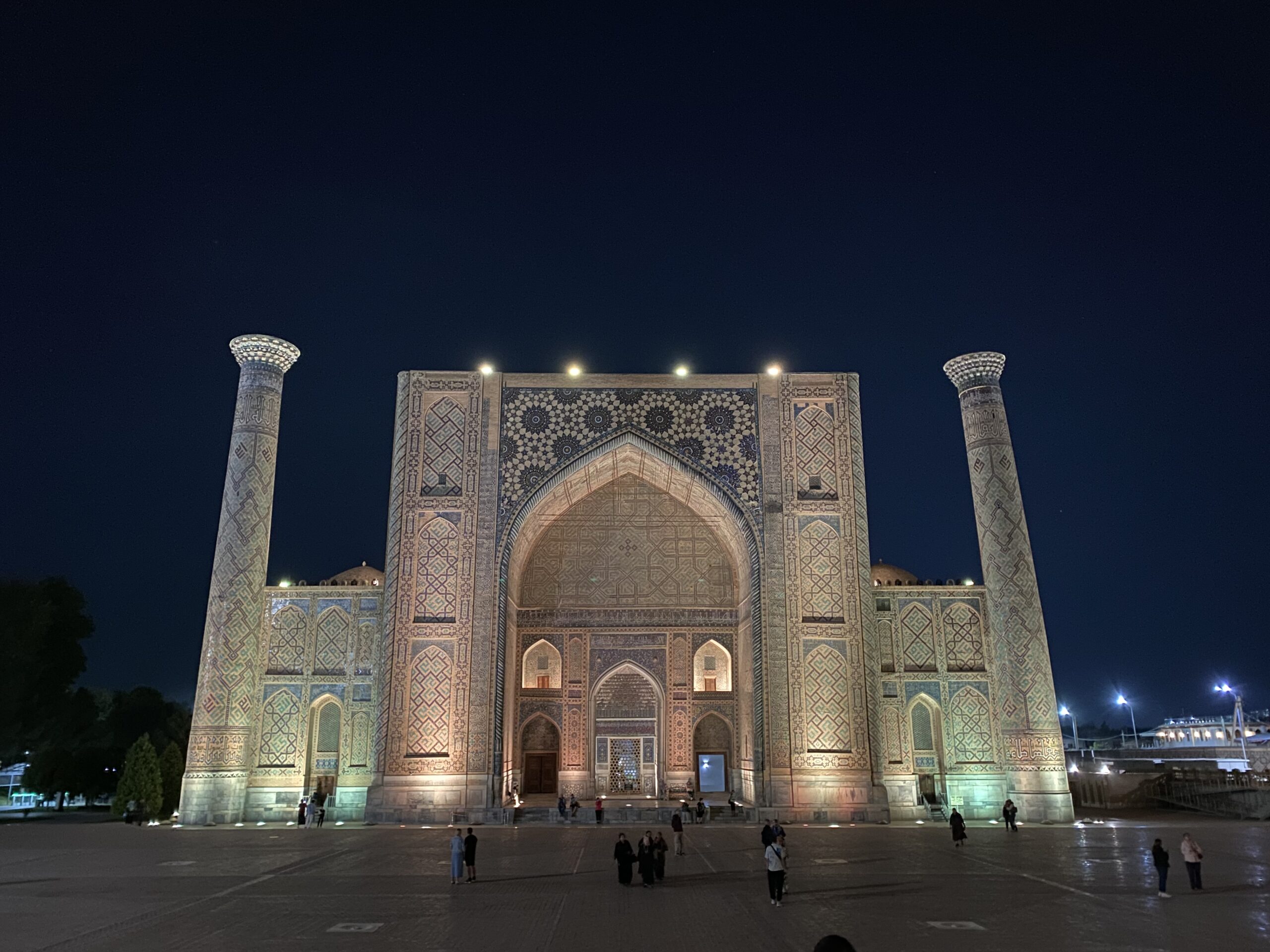Nestled in the heart of Central Asia, Uzbekistan calls travelers with its rich history, stories of the Silk Road, culture, and breathtaking landscapes. This double landlocked country offers a blend of ancient cities, vibrant markets, and warm hospitality. Uzbekistan is the perfect budget friendly destination to have an adventure! I found it to be a great introduction to Central Asia, with its rich tapestry of history and culture. Should not forget about the food! In this guide, I will take you on a journey through its bazaars, madrasas and history.
Quick Facts about Uzbekistan
Uzbekistan is a nation with a rich and diverse history. Surrounded by Kazakhstan, Tajikistan, Kyrgyzstan, Afghanistan, and Turkmenistan, it is often celebrated as the heart of Central Asia. It was once a key part of the Silk Road, connecting traders, pilgrims, and cultures. In 1991, Uzbekistan gained independence from the Soviet Union and since been developing its own unique identity post-USSR.
Written as of January 2024:
Currency: Uzbek Som (1 USD = 12 500 UZS)
56th largest country in the world
Capital: Tashkent
Population: 35.6 million – Central Asia’s most populous country!
Railway system: UZ Railway
Local airline: Uzbekistan Airways
Majority Religion: Muslim
Official Language: Uzbek
Also spoken: Russian, English

Uzbekistan for Budget Travel?
Uzbekistan is a prime destination for budget travelers who want to experience the essence of Central Asia without breaking the bank. Accommodation options range from low-cost hostels to affordable guesthouses, providing a comfortable stay at a fraction of what you’d pay in other touristy countries.
Public transportation is not only inexpensive but also an authentic way to see the country and meet locals. I elaborate more about it in the next section. The best part is that the entrance fees for many of Uzbekistan’s historical sites are less than 50 000 UZS (<USD$4), allowing you to soak up the history while being light on your wallet. Don’t get me started on the cuisine. It is full of flavor and can be enjoyed on a budget, with local markets offering delicious meals at very low prices. With these affordable options, Uzbekistan opens its doors to those seeking adventure and cultural immersion without the financial strain often associated with international travel.
Navigating the Central Asian Gem
Traveling through Uzbekistan on a budget is easier than you might think. The country’s infrastructure caters well to those looking to explore without splurging. With a little planning and flexibility, you can navigate the entire country quite economically.
Visas
Depending on where your passport is from, you may or may not require a visa to enter. For the most up to date information, check the official website for Uzbekistan’s e-Visa Portal or your local Uzbek embassy for your specific passport.
- British citizens don’t need a visa for tourist purposes for up to 30 days.
- EU/EEA citizens don’t need a visa for tourist purposes for up to 30 days.
- Australians don’t need a visa for tourist purposes for up to 30 days.
- Singaporeans don’t need a visa for tourist purposes for up to 30 days.
- US citizens will need to obtain a tourist visa.
Trains and Marshrutkas
I had some preconceived notions about Uzbekistan. One of them was that I didn’t realize how well connected Uzbekistan’s rail network was! It makes train travel an excellent option for exploring the country. The high-speed Afrosiyob train links the major cities of Tashkent, Samarkand, and Bukhara, offering a comfortable and efficient mode of transportation. Train tickets can be purchased from the Uzbek rail website. Tickets are released about 40 days before departure dates. I would recommend purchasing your tickets as early as you can, once you’ve narrowed down on your route. Of course you can risk purchasing the ticket at the station but you’ll probably only be able to take the slower trains – if that’s something that suits you.
There is also an app you can purchase your tickets from, which is run by Uzbek Railway. This app is really efficient for having your ticket as you will need to show your ticket for entry onto the train stations and trains.

For long distances, trains are your best bet, offering a reliable and scenic journey, particularly the high-speed Afrosiyob trains. Tickets are surprisingly affordable, and the experience of crossing the vast Uzbek landscapes is unforgettable.
- Afrosiyob: speed of 210 km/hr. This fast bullet train takes approximately 4hrs between Bukhara and Tashkent.
- Sharq: speed of 160 km/hr. Takes 6.5hrs between Bukhara and Tashkent
- Passenger Overnight Train: Takes 10ths between Bukhara and Tashkent overnight.
For more remote destinations or city-to-city travels, shared taxis known as “marshrutkas” are a common and economical option, though be prepared to haggle for a good price. Marshrutkas provide a flexible alternative, allowing travelers to reach smaller towns and villages.
Domestic Flights
If you’re short on time, consider domestic flights. Uzbekistan Airways connects major cities like Tashkent, Samarkand, and Bukhara, Khiva etc, allowing you to cover long distances in a fraction of the time it would take by road or rail. Domestic flights are really affordable considering.
Local Transport: Navigating Cities
Within cities, metered taxis, ride-sharing services, and public buses are available. Make sure you haggle the price of a taxi prior to starting your journey. The centers of Bukhara, Khiva and Samarkand they are walkable so taxis may not be required to get around.
When you’re in the capital, Tashkent, the metro system is hands down the best way to get around. The metro is not only a marvel of art and architecture but also an efficient and cheap way to get around. Tickets are incredibly cheap around Tashkent at 1400 UZS (0.10 cents), are efficient and clean. It is definitely an experience in itself with the station platforms being really ornate with detailed tiling. Allow yourself to be transported back to Soviet Uzbekistan as the stations were built during USSR. The trains carriages are still from that era.
Must See Destinations
Tashkent: The Capital
Tashkent, the capital of Uzbekistan, is a city where ancient history and modernity coexist seamlessly. As a budget traveler, you’ll find Tashkent to be surprisingly accessible. As mentioned above, the metro system is the best way to discover the city whilst being a time capsule. Considering it is the capital, Tashkent maintains low costs for food and entertainment, making it an ideal hub for your Uzbekistan travels. The city’s parks and fountains offer a tranquil escape, and they’re free to enjoy, blending the tranquility of the past with the pulse of the present.
Chor-Su Bazaar
feast for the senses and the wallet, with affordable local produce and vibrant crafts. The market is split up into different sections, think of it as a large open air shopping center. In the “main” building of Chor-Su, you will find produce and outside the fresh fruits and vegetables. Further away, you will find a sections for ceramics, clothes, carpets and even bread.
Metro Stations

Alright, don’t laugh. But I honestly do think that the Tashkent metro system is a work of art. The stations are beautifully designed and you are taken back in time to Soviet Era Uzbekistan. Each station has its own theme. It really is a cheap day out getting off at different stations and watching as life passes you. There isn’t too many signs in English but if you understand basic Russian or even Uzbek, you would know which station you’re at. It’s a really easy system to navigate.
Kukeldash Madrasah and the Hast Imam complex, where you can view one of the world’s oldest Qurans.
Samarkand: The Jewel of the Silk Road
As the heart of the Silk Road, Samarkand is known as the Jewel of the Silk Road. It has been a melting pot of cultures for centuries. Budget travelers can rejoice as most of Samarkand’s attractions have minimal entry fees. Samarkand’s mix of history, culture, and affordability makes it an essential stop on any Uzbek journey.
Registan Square

This iconic square is the heart of Samarkand. It is an architectural masterpiece with 3 madrasas surrounding the main square, with the main madrasas being Ulugh Beg Madrasas. It is Uzbekistan’s oldest madrasa built in 1417 by Timur (Turko-Mongol conqueror). This madrasa was built as the main center for teaching during the Timurid Empire, named after Timur’s grandson, astronomer and mathematician Ulugh Beg.
Arrive early to witness the golden hues of sunrise casting a magical glow or come in the evening to watch the Registan Light Show which can be viewed for free from the viewing platform at 2100hrs, every day. Entrance onto the grounds is 50 000 UZS.
Gur-Emir Mausoleum
Another masterpiece of Timurid architecture, this mausoleum houses the tomb of Timur and is a testament to the grandeur of his empire. In Persian, Gur-e-Amir translates to Tomb of the King. At the front of the complex, there is a beautiful courtyard and as you enter the mausoleum, you enter the tomb with walls so ornate and detailed, it really is a sight to behold. Ulugh Beg’s headstone can also be found here.
Shah-i-Zinda

Who would’ve thought a nicropolis would be an attraction? I guess it depends if you’re a dark tourist. Nonetheless, Shah-i-Zinda is a work of wonder with some of the most detailed and well preserved mausoleums I’ve seen. It is the final resting place of Qusam ibn-Abbas, the cousin to the Prophet Mohammed who is said to have brought Islam to the region in the 7th century. As the sun sets, the city’s monuments light up, offering a spectacle that is both free and priceless.
Siyob Bazaar
Wandering through the bustling Siyob Bazaar, you will find almost anything you want. From tapestry with local Uzbek fabrics to ceramics, local bread and food. Located off the side, there is a local tea house were you cans sample amazing Uzbek food and drink the local tea.
Observatory of Ulugh Beg

This observatory was built in 1940s by astronomer and mathematician Ulugh Beg. He was said to be one of the most important observational astronomers of his time. In the observatory, you’re able to see how time and the year was calculated before computers were a thing. It’s quite a remarkable feat and skill of Ulugh Beg as he achieved a greater precision in his calculations of the planetary movements and determining the length of a year with an error of 58 seconds to modern calculations.
Bibi-Khanym Mosque
According to legend, this mosque was built by Timur’s wife, Bibi-Khanym. However, the architect designing the mosque had fallen in love with Bibi-Khanum and had delayed construction of the mosque. It was said that he would only hurry and complete construction if he could kissed her. However, his kiss left a mark on her cheek and he was found out, later executed by Timur. This is also the final resting place of Bibi-Khanym.
Bukhara: A Living Museum
Bukhara is a city that feels like an open-air museum, it is after all a UNESCO World Heritage site. Each corner telling a story of the ancient Silk Road. Wandering through the historic center’s alleys, you can admire the intricate tile work on the madrasas. The city is compact, making it easy to visit multiple historic sites in a single day and all on foot. The town center comes alive towards the evenings with local artisans and storytellers. This was probably my favourite city to visit in Uzbekistan because of how intimate it felt.
The Ark Fortress

Built in the 5th century, this ancient citadel served as a royal palace, witnessing centuries of history within its walls. It was used as a fortress until Soviet rule.
Lyabi-Hauz Ensemble
This is one of the main squares in Bukhara. Sitting at the foot of the Lyabi-Hauz mosque, this charming plaza is a great place to people watch. In the center is a large pool where you’re able to dine around.
Chor Minor

This building is really different to all the others in Bukhara. It is also a lot more modern, built in the 1800s. It is said that it was inspired by the Char Minar Mosque in India. Across this building, there is a multi-generational local family sells Soviet Era memorabilia if that’s something you’re interested in.
Madrasa Trading domes
This complex is homed to plenty of local vendors selling their local crafts and goods. You can observe locals crafting things in real time, be it paintings or cravings. The building was built in the 15th century. While it was not existent during the peak of the Silk Road, you can imagine what life would’ve been like in those days by visiting the Trading Domes.
Po-i-Kalan (Kalan Minaret, Kalan Mosque and Mir-i-Arab Madrasa)

Kalan Mosque & Minaret: The minaret was once said to be the tallest building in the region. The Kalan Mosque was previously destroyed by Chinggis Khan in 1220 AD, however he had spared the minaret. During the 15th century, under Timurid rule, the mosque was rebuilt and is what is presently standing.
Mir-i-Arab Madrasa: In Arab, Mir-i-Arab is translated to Prince of the Arabs. The madrasa was constructed in the 15th century. This is still a function madrasa and visitors are not permitted to enter. The madrasa only accepts 24 students each year to study there.
Uzbek Cuisine
Food is everything we are. It’s an extension of nationalist feeling, ethnic feeling, your personal history, your province, your region, your tribe, your grandma. It’s inseparable from those from the get-go. – Anthony Bourdain
When in Uzbekistan, indulging in street food is a delight for your taste buds. Uzbekistan has a rich culinary tradition that reflects the country’s history and cultural influences. These dishes are incredibly affordable, usually priced modestly in local eateries, making it possible to eat well without spending much. Sampling traditional food in Uzbekistan is not only a gastronomic adventure but also a cultural immersion. Here is a list of some of the must-try dishes you should try on your visit!!

Plov: The National Dish
This fragrant rice dish, cooked with meat, carrots, onions, and spices, is a staple of Uzbek cuisine. Each region puts its own spin on plov, making it a must-try in different cities. Uzbekistan’s national dish, a hearty rice pilaf typically made with mutton, horse meat, lamb or beef.
Samsa
A savory and flaky pastry filled with spiced meat or vegetables, baked to perfection in a tandoor oven. Similar to a samosa or empanada.
Manti
These succulent steamed dumplings, typically filled with minced meat and onions, are served with a dollop of yogurt and a sprinkle of fresh herbs. They’re a true delight for the taste buds. Steamed dumplings filled with meat or vegetables, similar to Chinese or Turkish dumplings.

Uzbek flatbread
A type of flatbread that is a staple of Uzbek cuisine, typically baked in a tandoor oven and served with meals. To prevent the bread from puffing up and turning into a ball, the Uzbeks use wooden stamps made of walnut with iron pins called chekich to create patterns and reduce the rise.
Shashlik
Uzbekistan’s version of kebabs, shashlik features succulent chunks of marinated meat on skewers grilled to perfection over an open flame. This dish is often served with fresh vegetables and Uzbek bread.
Lagman
A delicious noodle soup bursting with flavour and is made with meat, vegetables, herbs and spices.

Uzbek Wine
Uzbekistan has a long history of winemaking, and the country produces a range of delicious red and white wines made from local grape varieties.
Other must-try’s
Chuchvara: small boiled dumplings filled with meat or vegetables and served with yogurt or sour cream.
Green tea: fragrant and flavorful herbal tea. Sweets or dried fruits are often served with it.
Ayran: a refreshing and tangy yogurt drink that is a popular accompaniment to meals.
Overall, Uzbekistan’s cuisine is rich, flavorful, and diverse, and there are many delicious dishes and drinks to try during your visit to the country!
Cultural Nuances
Packing for Uzbekistan – Dress Modestly

Packing for Uzbekistan calls for a mix of practicality and respect for local culture. Due to the warm climate in the summer climate, it is advisable to pack lightweight and loose-fitting clothing. As majority of the must visit sites are religious sites, remember to cover your shoulders and knees when visit. For women, you will need to wear a headscarf but a light weight scarf should suffice. A comfortable pair of walking shoes is recommended as you will be doing a lot of walking on the cobblestone streets of historic cities.
Greetings and Hospitality
Uzbeks are known for their warm hospitality. A polite greeting, a smile, and a few basic phrases in Uzbek or Russian can go a long way in establishing positive interactions.
Bargaining at Bazaars
At the local bazaars, bargaining is a common practice. Approach it with good humor and a respectful attitude, and you’ll likely walk away with unique souvenirs at fair prices. Alternatively, there are a lot of shops selling similar souvenirs so you could “shop around” finding the best price bargaining is something you’re not comfortable with. I personally didn’t find the need to barter as I thought everything to be well priced.

Uzbekistan, with its timeless cities and warm-hearted people, is a treasure trove of experiences waiting to be uncovered. From the majesty of Samarkand to the tranquil courtyards of Bukhara, every step in this ancient land reveals a piece of its storied history. So pack your bags, immerse yourself in the rich tapestry of Uzbek culture, and embark on an unforgettable journey through the Silk Road splendors.


Leave a Reply